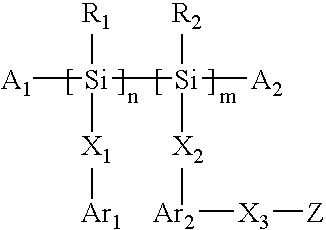Polysilane-based charge transport materials
a charge transport material and polysilane technology, applied in the field of polysilane, can solve the problems of reducing the performance of the organophotoreceptor, affecting the formation of the photoconductive element, and the addition of the liquid electrophotography problem, so as to reduce the need for a polymer binder, reduce the need for extraction, and improve the electrostatic properties
- Summary
- Abstract
- Description
- Claims
- Application Information
AI Technical Summary
Benefits of technology
Problems solved by technology
Method used
Image
Examples
example 1
Synthesis and Characterization Charge Transport Materials
[0137] This example describes the synthesis and characterization of Polymers (1)-(14) in which the numbers refer to formula numbers above. The characterization involves chemical characterization of the compositions. The electrostatic characterization, such as mobility and ionization potential, of the materials formed with the compositions is presented in a subsequent example.
Synthesis of Poly(methylphenylsilane) of Formula (III) where R1=R2=methyl, X1=X2=a Bond, and Ar1=Ar2=1,4 Phenylene
[0138] A mixture of sodium metal (11 g, 0.48 mol) and 140 ml dry toluene was added under dry nitrogen atmosphere to a 500 ml four-neck round-bottom flask equipped with a dry nitrogen supply inlet, a reflux condenser, a pressure equalizing addition funnel and a motor-driven steel wire stirrer. The mixture was refluxed and stirred vigorously to form a dispersion of sodium in toluene. The stirred sodium dispersion was heated to a gentle reflux...
example 2
Charge Mobility Measurements
[0162] This example describes the measurement of charge mobility and ionization potential for charge transport materials, specifically Polymer (1).
Sample 1
[0163] 0.1 g of the Polymer (1) was dissolved in 2 ml of tetrahydrofuran (THF). The solution was coated on a polyester film with a conductive aluminum layer by a dip roller. After the coating was dried for 1 hour at 80° C., a clear 10 μm thick layer was formed. The hole mobility of the sample was measured and the results are presented in Table 1.
Mobility Measurements
[0164] Each sample was corona charged positively up to a surface potential U and illuminated with 2 ns long nitrogen laser light pulse. The hole mobility μ was determined as described in Kalade et al., “Investigation of charge carrier transfer in electrophotographic layers of chalkogenide glasses,” Proceeding IPCS 1994: The Physics and Chemistry of Imaging Systems, Rochester, N.Y., pp. 747-752, incorporated herein by reference. The ho...
example 3
Ionization Potential Measurements
[0166] This example describes the measurement of the ionization potential for the charge transport materials described in Example 1.
[0167] To perform the ionization potential measurements, a thin layer of a charge transport material about 0.5 μm thickness was coated from a solution of 2 mg of the charge transport material in 0.2 ml of tetrahydrofuran on a 20 cm2 substrate surface. The substrate was an aluminized polyester film coated with a 0.4 μm thick methylcellulose sub-layer.
[0168] Ionization potential was measured as described in Grigalevicius et al., “3,6-Di(N-diphenylamino)-9-phenylcarbazole and its methyl-substituted derivative as novel hole-transporting amorphous molecular materials,” Synthetic Metals 128 (2002), p. 127-131, incorporated herein by reference. In particular, each sample was illuminated with monochromatic light from the quartz monochromator with a deuterium lamp source. The power of the incident light beam was 2-5.10−8 W. A ...
PUM
| Property | Measurement | Unit |
|---|---|---|
| thickness | aaaaa | aaaaa |
| thickness | aaaaa | aaaaa |
| thickness | aaaaa | aaaaa |
Abstract
Description
Claims
Application Information
 Login to View More
Login to View More - R&D
- Intellectual Property
- Life Sciences
- Materials
- Tech Scout
- Unparalleled Data Quality
- Higher Quality Content
- 60% Fewer Hallucinations
Browse by: Latest US Patents, China's latest patents, Technical Efficacy Thesaurus, Application Domain, Technology Topic, Popular Technical Reports.
© 2025 PatSnap. All rights reserved.Legal|Privacy policy|Modern Slavery Act Transparency Statement|Sitemap|About US| Contact US: help@patsnap.com



